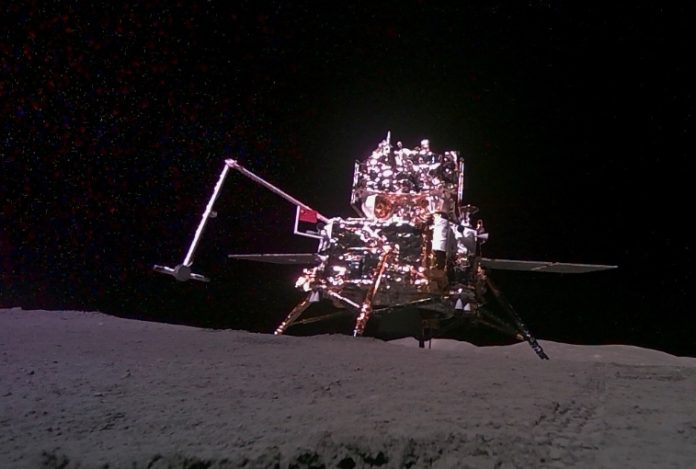China’s lunar spacecraft Chang’e 6 unfurled the country’s red-and-gold flag on the far side of the moon for the first time before part of the vehicle set off early Tuesday morning with rock and soil samples to be delivered to Earth, Chinese media reported.
The Chang’e-6 probe travelled into space last month and its landing module landed on the far side of the moon on Sunday. The vehicle lifted off at 7:38 Beijing time on Tuesday morning, its engine burning for about six minutes as it entered a preset orbit around the moon, the China National Space Administration said.
The agency said the Chang’e 6 survived a high-temperature test on the lunar surface and obtained samples through drilling and surface collection before stowing them in a container inside the probe’s lifting device as planned.
The container will be transferred to the descent capsule, which is scheduled to return to Earth in the deserts of China’s Inner Mongolia region around June 25.
The small flag, which the agency said was made of special composite materials, appeared on a retractable arm deployed from the side of the lunar lander and was not placed on the lunar soil, according to an animation of the mission released by the agency.
Foreign Ministry spokesperson Hua Chunying wrote on X:
“Mission accomplished! An unprecedented feat in human lunar exploration history!”
Missions to the back side of the moon
Missions to the far side of the moon are more difficult because it does not face the Earth and requires a transponder satellite to maintain communications. In addition, the terrain is more rugged and there are fewer flat areas to land.
Xinhua reported that the probe’s landing site was the South Pole-Aitken Basin, an impact crater formed more than 4 billion years ago, 8 miles deep and 1,500 miles in diameter.
It is the oldest and largest such crater on the moon, so it may provide the earliest information about it, Xinhua reported, adding that the huge impact may have ejected materials from deep beneath the surface.
The mission is the sixth in the Chang’e lunar exploration programme, named after the Chinese moon goddess. It is the second mission designed to return samples, following Chang’e 5, which travelled to the moon in 2020.
The lunar programme is part of a growing rivalry with the US, which remains the leader in space exploration, and other countries including Japan and India. China currently maintains a three-person crew on its own space station orbiting the Earth and aims to send astronauts to the moon by 2030. Three more Chinese lunar probe missions are planned over the next four years.
If China succeeds in landing a man on the moon, it will become the second nation after the US to do so. America plans to land astronauts on the moon again – for the first time in more than 50 years – although NASA earlier this year pushed back the target date to 2026.
